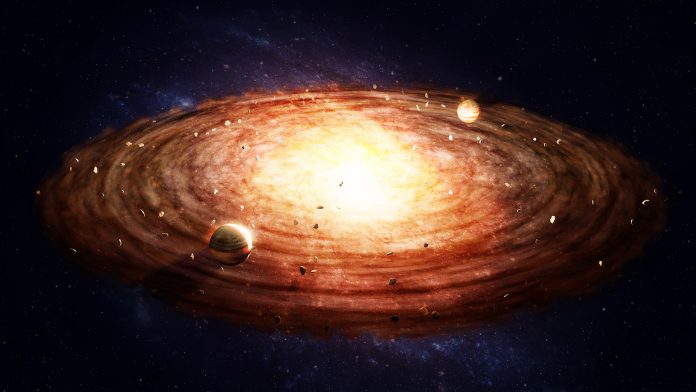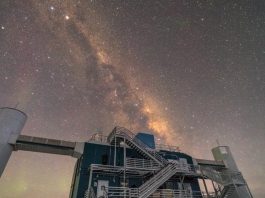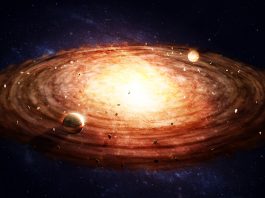Researchers from the University of Warwick have made a new discovery that offers a new small planet formation theory.
In a new study, University of Warwick researchers investigated the birth environment of planets, areas of gas and dust that swirl around a central star, known as the protoplanetary disc.
Through the investigation, the team discovered a new planet formation theory in the region, not described in previous research.
The work has been submitted to the journal of Monthly Notices of the Royal Astronomical Society and is shown at the National Astronomy Meeting, beginning today, 3 July 2023.
A new planet formation theory: Sandwiched planet formation
The team showed how two large planets in the protoplanetary disc can perhaps give rise to a smaller planet between them. The researchers termed this new planet formation theory ‘sandwiched planet formation.’
This occurs because the two original large planets restrict an inwards flow of dust. The amount of dust that collects between them is then reduced compared to when there is no outer planet.
If that dust was to eventually come together to form a planet, the middle planet is likely to be smaller than the other outer planets. This middle planet is alike the filling of a sandwich.
Although further research is needed, the new planet formation theory could be a possible explanation for the formation of small planets. For example, it could explain how planets like Mars and Uranus, which are surrounded by larger planets, were formed.
Dust rings have a potential role in how a planet is formed
The researchers stated that over the last decade, observations showed that rings and gaps exist in protoplanetary disks. The gaps are where planets are expected to be.
They argued that theory work has shown that planets cause dust rings to form exterior to the gaps.
An important question is then raised to astronomers as to what is happening in the rings.
Associate Professor and Dorothy Hodgkin Fellow, Farzana Meru, from the Department of Physics at the University of Warwick, said: “In our study, we propose the rings as sites of planet formation; specifically, that there are sandwiched planets currently being formed in those rings.
“This is very different to the conventional view of planet formation, where we typically expect that the planets form sequentially from the inside to the outside of the disc and get more and more massive further out.
“What is also really interesting is that there are examples that we have found from exoplanet observations that actually show this sandwiched planet architecture — where the middle planet is less massive than its neighbours; it is a reasonable proportion of the systems too.”
Revolutionising the field of planet formation
Meru concluded: “The field of planet formation has been revolutionised recently. High resolution images of planet-forming discs have come out in the last ten years, since a new sophisticated telescope (the Atacama Large Millimeter/submillimeter Array) started observing the night sky. These images have given us clues about how planets form and evolve; it’s exciting to be at the forefront of this research.”









